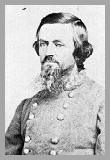With Rosecrans confined to Chattanooga, Burnside had to rely on his own forces -- 20,000 strong -- to guard East Tennessee from not only Bragg's army on his right flank but a large force under General Sam Jones, from West Virginia, on his left. Wolford, with the removal of Byrd's brigade, was likewise on his own. Instead of taking the offensive, he waited for the enemy's arrival, while serving as Burnside's eyes and ears. The rebels, however, were also busy gathering information about their foes, as Wolford discovered when loyal citizens exposed a suspicious-looking female visitor to the camp as a Confederate spy. On the 10th Wolford ordered Captain Stover of the 45th, his brigade provost marshal, to arrest her. Stover selected one of his gentler-spirited, if plainer-looking, guards for the task, which he carried out resolutely, even when the woman flew into a rage and tried to ride away, saying she had to look after her children. The guard, however, refused to release the bridle of her horse, despite her tears and protests -- and the Confederacy was denied whatever news she had intended to provide. |

Getting word that a large rebel force had crossed the Hiwassee and occupied Athens on the night of the 10th, Wolford notified Brigadier General Mahlon D. Manson at Knoxville, the commander of the 23rd Corps, who ordered him to retreat to Philadelphia. On the 11th Confederates forces appeared to Wolford's front and right. That afternoon, Wolford tried to set a trap by beating a hasty retreat two and a half miles to his rear, then forming his troops in two lines, one on each flank, to await the enemy's arrival. They did not show, whether from prudence or tardiness, and Wolford marched into Philadelphia on the 12th. After his arrival, Wolford sent out scouting parties, including one led by Captain Elias F. Scott of Company A of the 45th, who returned on the night of the 12th with news of a small rebel party camping at Prigmore's farm, but little else. ("An intelligent and efficient officer" according to Tarrant [Wild Riders, 295], Scott was wounded in the Battle of Resaca and died on May 17, 1864.) On the 14th Wolford reported to Burnside that all but a few hundred of the enemy on his right and left flanks had fallen back. These he was trying to capture, taking forty-five in the past few days alone, while losing nine of his men, including a lieutenant, as captives to the rebels. On the 15th, while foraging six miles from camp, the wagons of the 45th were attacked by a force of 100 Confederates, but the guard managed to drive them off. Lieutenant Colonel Silas Adams rode out with 300 men to give chase and, encountering the rebels scattered along the road to Decatur, captured 25 of them, while freeing nine men from the 1st and 5th Tennessee, who had been taken prisoner near Kingston that morning. After this encounter, the rebels became more cautious in their movements, but Wolford learned from his scouts that a large Confederate cavalry force had gathered at Charleston, on the Hiwassee River. Wolford's information proved to be correct, but it was not enough to save him. |
That force was under Major General Carter L. Stevenson, who had taken command on the 17th on Bragg's orders. Arriving at Charleston two days later, Stevenson ordered Dibrell to attack Philadelphia with his brigade, which consisted of the 4th, 10th, 11th 13th and 19th Tennessee Cavalry regiments. He was reinforced by detachments from the 39th and 59th Tennessee Mounted Infantry, which were stationed at Sweet Water, and a battery of four cannons under the command of Captain Amariah Huggins. |
Stevenson also ordered Colonel James J. Morrison to cross the Hiwassee, at a point below Dibrell, head north and rejoin Dibrell at Philadelphia. Morrison's command included the 16th Battalion of Georgia Cavalry and the 16th Tennessee Cavalry Battalion, as well as the 3rd Confederate, 6th North Carolina and the 1st, 2nd and 6th Georgia cavalry regiments -- altogether about 1,800 men. The plan, Stevenson told his two commanders, was to catch Wolford in a pincer, with Dibrell to the front and Morrison to the rear, the tactic that their former leader, Forrest, had used to such effect in so many engagements. They were to attack at daylight on the 20th, with Dibrell moving northeast from Sweet Water, following the East Tennessee and Georgia rail line, and Morrison taking back roads to the west of Philadelphia, behind hills that hid him from Federal view. He was to circle around the town and head southwest, cutting off Wolford's retreat to Loudon. If Wolford was not at Philadelphia, Dibrell and Morrison were, wrote Stevenson in his report, to "seek and capture, or drive him across the Tennessee." Having routed Wolford's cavalry, they were to proceed to Loudon and, continued Stevenson, "should the force of the enemy's infantry there be small, (they) will attack and carry that place" (War of the Rebellion: A Compilation of the Official Records of the Union and Confederate Armies: Series 1, Vol. 31, Part 1 [Knoxville and Lookout Mountain]). |
Maj. Gen. Carter L. Stevenson |
Col. G.G. Dibrell |
Thumbnail map of East Tennessee, showing Philadelphia. Click for full-sized version. From the collection of Gerald D. Hodge |


